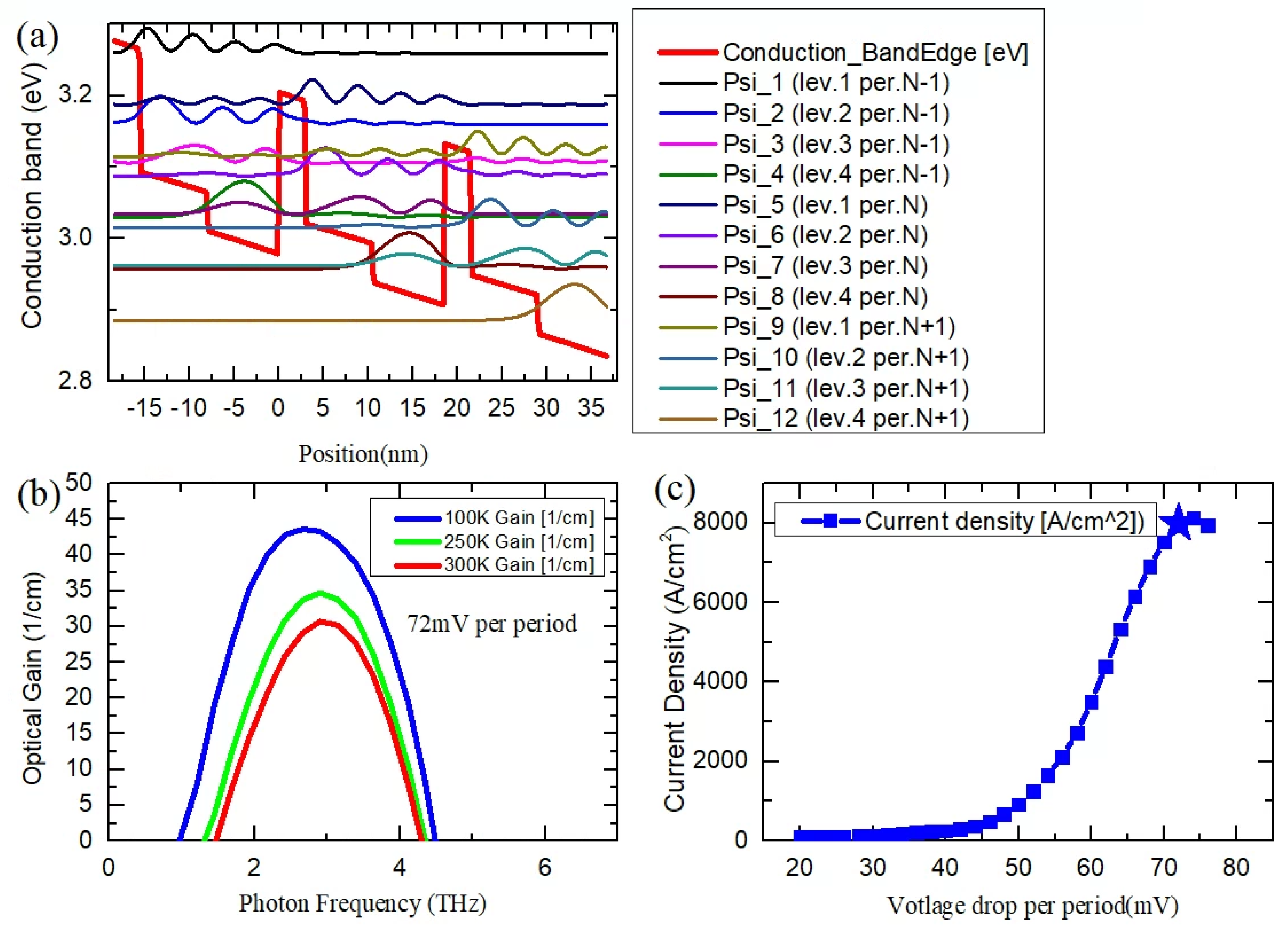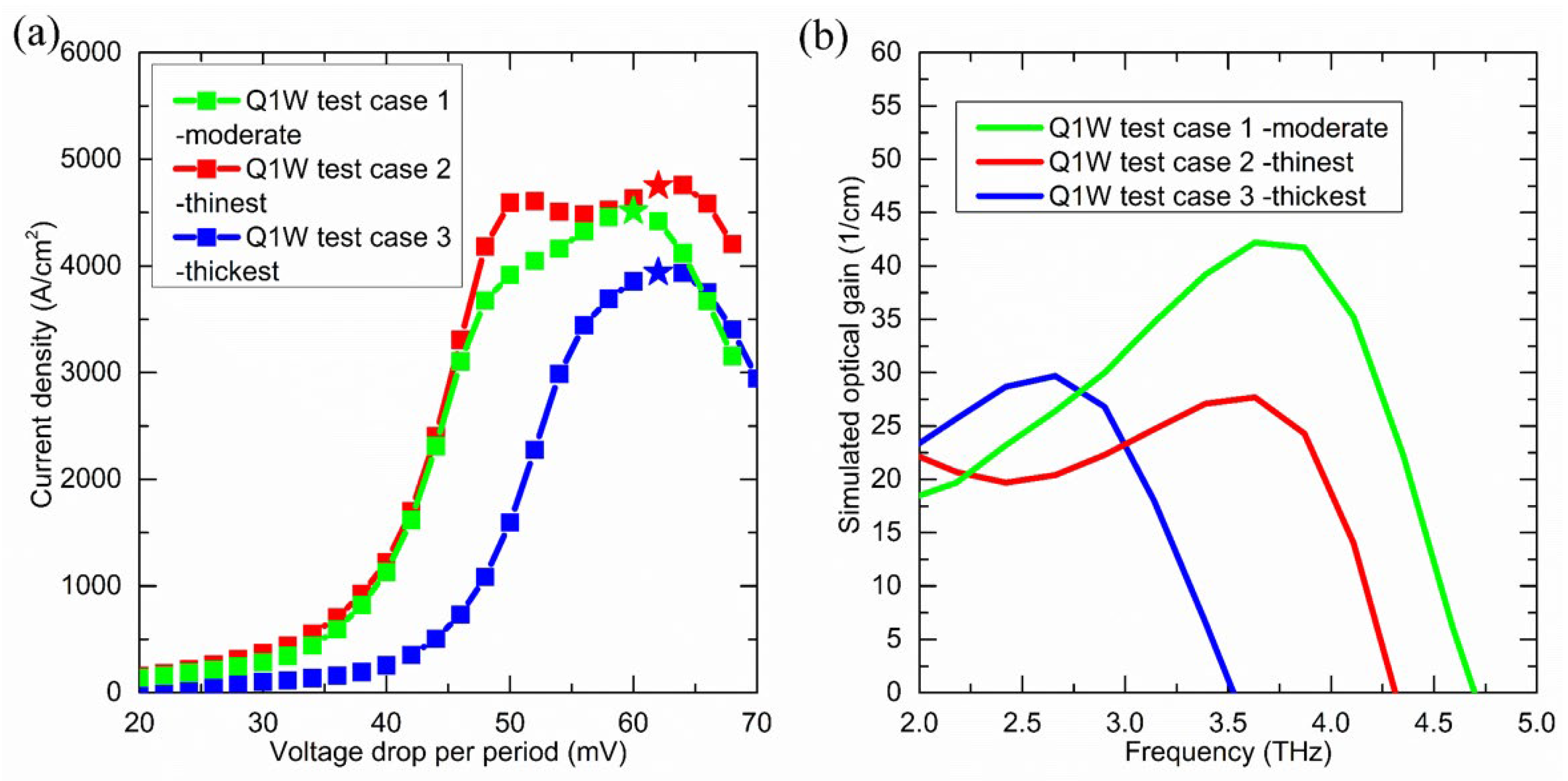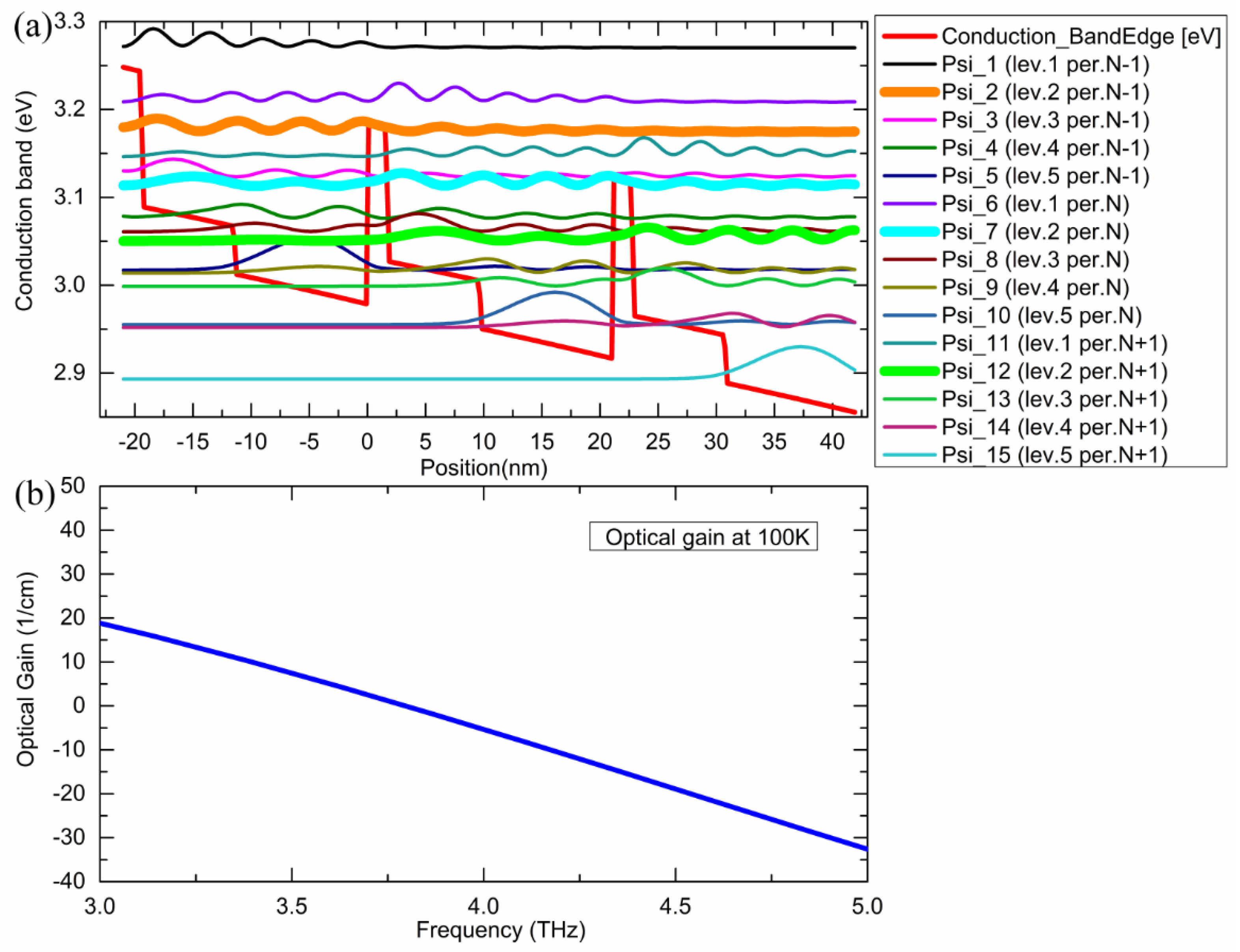Theoretical Study of Quasi One-Well Terahertz Quantum Cascade Laser
Abstract
:1. Introduction
2. The Q1W Design Concept
3. Development of the Q1W Design
4. Discussions Investigation of Temperature Sensitivity
5. Critical Design Parameters
5.1. Effect of Step-Tapered Barrier Thickness
5.2. Effect of High-Energy Parasitic Energy Levels
6. Conclusions
Author Contributions
Funding
Acknowledgments
Conflicts of Interest
References
- Köhler, R.; Tredicucci, A.; Beltram, F.; Beere, H.E.; Linfield, E.H.; Davies, A.G.; Ritchie, D.A.; Iotti, R.C.; Rossi, F. Terahertz semiconductor-heterostructure laser. Nature 2002, 417, 156–159. [Google Scholar] [CrossRef] [PubMed]
- Bosco, L.; Franckié, M.; Scalari, G.; Beck, M.; Wacker, A.; Faist, J. Thermoelectrically cooled THz quantum cascade laser operating up to 210 K. Appl. Phys. Lett. 2019, 115, 010601. [Google Scholar] [CrossRef]
- Williams, B.S. Terahertz quantum-cascade lasers. Nat. Photonics 2007, 1, 517–525. [Google Scholar] [CrossRef] [Green Version]
- Kumar, S.; Chan, C.W.I.; Hu, Q.; Reno, J.L. A 1.8-THz quantum cascade laser operating significantly above the temperature of ℏ ω/k B. Nat. Phys. 2011, 7, 166–171. [Google Scholar] [CrossRef]
- Fathololoumi, S.; Dupont, E.; Chan, C.; Wasilewski, Z.; Laframboise, S.; Ban, D.; Mátyás, A.; Jirauschek, C.; Hu, Q.; Liu, H. Terahertz quantum cascade lasers operating up to ∼200 K with optimized oscillator strength and improved injection tunneling. Opt. Express 2012, 20, 3866–3876. [Google Scholar] [CrossRef]
- Scalari, G.; Ajili, L.; Faist, J.; Beere, H.; Linfield, E.; Ritchie, D.; Davies, G. Far-infrared (λ = 87 μm) bound-to-continuum quantum-cascade lasers operating up to 90 K. Appl. Phys. Lett. 2003, 82, 3165–3167. [Google Scholar] [CrossRef]
- Scalari, G.; Hoyler, N.; Giovannini, M.; Faist, J. Terahertz bound-to-continuum quantum-cascade lasers based on optical-phonon scattering extraction. Appl. Phys. Lett. 2005, 86, 181101. [Google Scholar] [CrossRef]
- Vitiello, M.S.; Scamarcio, G.; Spagnolo, V.; Dhillon, S.S.; Sirtori, C. Terahertz quantum cascade lasers with large wall-plug efficiency. Appl. Phys. Lett. 2007, 90, 191115. [Google Scholar] [CrossRef]
- Albo, A.; Flores, Y.V.; Hu, Q.; Reno, J.L. Two-well terahertz quantum cascade lasers with suppressed carrier leakage. Appl. Phys. Lett. 2017, 111, 111107. [Google Scholar] [CrossRef]
- Liu, J.; Chen, J.; Wang, T.; Li, Y.; Liu, F.; Li, L.; Wang, L.; Wang, Z. High efficiency and high power continuous-wave semiconductor terahertz lasers at ∼3.1 THz. Solid-State Electron. 2013, 81, 68–71. [Google Scholar] [CrossRef]
- Freeman, J.R.; Brewer, A.; Madéo, J.; Cavalié, P.; Dhillon, S.S.; Tignon, J.; Beere, H.E.; Ritchie, D.A. Broad gain in a bound-to-continuum quantum cascade laser with heterogeneous active region. Appl. Phys. Lett. 2011, 99, 241108. [Google Scholar] [CrossRef]
- Amanti, M.I.; Scalari, G.; Terazzi, R.; Fischer, M.; Beck, M.; Faist, J.; Rudra, A.; Gallo, P.; Kapon, E. Bound-to-continuum terahertz quantum cascade laser with a single-quantum-well phonon extraction/injection stage. New J. Phys. 2009, 11, 125022. [Google Scholar] [CrossRef]
- Schrottke, L.; Lü, X.; Rozas, G.; Biermann, K.; Grahn, H.T. Terahertz GaAs/AlAs quantum-cascade lasers. Appl. Phys. Lett. 2016, 108, 102102. [Google Scholar] [CrossRef]
- Deutsch, C.; Detz, H.; Krall, M.; Brandstetter, M.; Zederbauer, T.; Andrews, A.; Schrenk, W.; Strasser, G.; Unterrainer, K. Dopant migration effects in terahertz quantum cascade lasers. Appl. Phys. Lett. 2013, 102, 201102. [Google Scholar] [CrossRef]
- Chassagneux, Y.; Wang, Q.; Khanna, S.; Strupiechonski, E.; Coudevylle, J.-R.; Linfield, E.; Davies, A.; Capasso, F.; Belkin, M.; Colombelli, R. Limiting factors to the temperature performance of THz quantum cascade lasers based on the resonant-phonon depopulation scheme. IEEE Trans. Terahertz Sci. Technol. 2011, 2, 83–92. [Google Scholar] [CrossRef]
- Sirtori, C.; Barbieri, S.; Colombelli, R. Wave engineering with THz quantum cascade lasers. Nat. Photonics 2013, 7, 691–701. [Google Scholar] [CrossRef]
- Walther, C.; Fischer, M.; Scalari, G.; Terazzi, R.; Hoyler, N.; Faist, J. Quantum cascade lasers operating from 1.2 to 1.6 THz. Appl. Phys. Lett. 2007, 91, 131122. [Google Scholar] [CrossRef]
- Wen, B.; Ban, D. High-temperature Terahertz Quantum Cascade Lasers. Prog. Quantum Electron. 2021, 80, 100363. [Google Scholar] [CrossRef]
- Baranov, A.; Nguyen-Van, H.; Loghmari, Z.; Bahriz, M.; Teissier, R. Terahertz quantum cascade laser with non-resonant extraction. AIP Adv. 2019, 9, 055214. [Google Scholar] [CrossRef]
- Kainz, M.A.; Schönhuber, S.; Andrews, A.M.; Detz, H.; Limbacher, B.; Strasser, G.; Unterrainer, K. Barrier height tuning of terahertz quantum cascade lasers for high-temperature operation. ACS Photonics 2018, 5, 4687–4693. [Google Scholar] [CrossRef]
- Luo, H.; Laframboise, S.; Wasilewski, Z.; Aers, G.; Liu, H.; Cao, J. Terahertz quantum-cascade lasers based on a three-well active module. Appl. Phys. Lett. 2007, 90, 041112. [Google Scholar] [CrossRef]
- Wen, B.; Xu, C.; Wang, S.; Wang, K.; Tam, M.C.; Wasilewski, Z.; Ban, D. Dual-lasing channel quantum cascade laser based on scattering-assisted injection design. Opt. Express 2018, 26, 9194–9204. [Google Scholar] [CrossRef] [PubMed]
- Dupont, E.; Fathololoumi, S.; Wasilewski, Z.; Aers, G.; Laframboise, S.; Lindskog, M.; Razavipour, S.; Wacker, A.; Ban, D.; Liu, H. A phonon scattering assisted injection and extraction based terahertz quantum cascade laser. J. Appl. Phys. 2012, 111, 073111. [Google Scholar] [CrossRef] [Green Version]
- Razavipour, S.; Dupont, E.; Chan, C.; Xu, C.; Wasilewski, Z.; Laframboise, S.; Hu, Q.; Ban, D. A high carrier injection terahertz quantum cascade laser based on indirectly pumped scheme. Appl. Phys. Lett. 2014, 104, 041111. [Google Scholar] [CrossRef]
- Razavipour, S.G.; Dupont, E.; Fathololoumi, S.; Chan, C.; Lindskog, M.; Wasilewski, Z.; Aers, G.; Laframboise, S.; Wacker, A.; Hu, Q. An indirectly pumped terahertz quantum cascade laser with low injection coupling strength operating above 150 K. J. Appl. Phys. 2013, 113, 203107. [Google Scholar] [CrossRef]
- Franckié, M.; Bosco, L.; Beck, M.; Bonzon, C.; Mavrona, E.; Scalari, G.; Wacker, A.; Faist, J. Two-well quantum cascade laser optimization by non-equilibrium Green’s function modelling. Appl. Phys. Lett. 2018, 112, 021104. [Google Scholar] [CrossRef] [Green Version]
- Scalari, G.; Amanti, M.; Walther, C.; Terazzi, R.; Beck, M.; Faist, J. Broadband THz lasing from a photon-phonon quantum cascade structure. Opt. Express 2010, 18, 8043–8052. [Google Scholar] [CrossRef]
- Albo, A.; Flores, Y.V.; Hu, Q.; Reno, J.L. Split-well direct-phonon terahertz quantum cascade lasers. Appl. Phys. Lett. 2019, 114, 191102. [Google Scholar] [CrossRef] [Green Version]
- Freeman, W. Longitudinal-optical phonon absorption and dephasing in three-level terahertz quantum cascade structures with different injector anticrossings. J. Appl. Phys. 2020, 128, 235702. [Google Scholar] [CrossRef]
- Wacker, A. Extraction-controlled quantum cascade lasers. Appl. Phys. Lett. 2010, 97, 081105. [Google Scholar] [CrossRef] [Green Version]
- Han, Y.; Li, L.; Grier, A.; Chen, L.; Valavanis, A.; Zhu, J.; Freeman, J.; Isac, N.; Colombelli, R.; Dean, P. Extraction-controlled terahertz frequency quantum cascade lasers with a diagonal LO-phonon extraction and injection stage. Opt. Express 2016, 24, 28583–28593. [Google Scholar] [CrossRef] [PubMed] [Green Version]
- Wen, B.; Deimert, C.; Wang, S.; Xu, C.; Rassel, S.S.; Wasilewski, Z.; Ban, D. Six-level hybrid extraction/injection scheme terahertz quantum cascade laser with suppressed thermally activated carrier leakage. Opt. Express 2020, 28, 26499–26508. [Google Scholar] [CrossRef] [PubMed]
- Cooper, J.; Valavanis, A.; Ikonić, Z.; Harrison, P.; Cunningham, J. Finite difference method for solving the Schrödinger equation with band nonparabolicity in mid-infrared quantum cascade lasers. J. Appl. Phys. 2010, 108, 113109. [Google Scholar] [CrossRef]
- Khalatpour, A.; Paulsen, A.K.; Deimert, C.; Wasilewski, Z.R.; Hu, Q. High-power portable terahertz laser systems. Nat. Photonics 2021, 15, 16–20. [Google Scholar] [CrossRef]
- The nextnano.NEGF Software for Quantum Transport. Available online: https://nextnano-docu.northeurope.cloudapp.azure.com/dokuwiki/doku.php?id=negf:the_nextnano.negf_software (accessed on 6 October 2020).
- Sekine, N.; Hirakawa, K. Dispersive terahertz gain of a nonclassical oscillator: Bloch oscillation in semiconductor superlattices. Phys. Rev. Lett. 2005, 94, 057408. [Google Scholar] [CrossRef]
- Winge, D.O.; Dupont, E.; Wacker, A. Ignition of quantum cascade lasers in a state of oscillating electric field domains. Phys. Rev. A 2018, 98, 023834. [Google Scholar] [CrossRef] [Green Version]
- Winge, D.O.; Franckié, M.; Wacker, A. Superlattice gain in positive differential conductivity region. AIP Adv. 2016, 6, 045025. [Google Scholar] [CrossRef] [Green Version]
- Gower, N.L.; Piperno, S.; Albo, A. Comparison of THz-QCL Designs Supporting Clean N-Level Systems. Photonics 2021, 8, 248. [Google Scholar] [CrossRef]
- Wang, L.; Lin, T.-T.; Wang, K.; Grange, T.; Birner, S.; Hirayama, H. Short-period scattering-assisted terahertz quantum cascade lasers operating at high temperatures. Sci. Rep. 2019, 9, 9446. [Google Scholar] [CrossRef]
- Jirauschek, C.; Kubis, T. Modeling techniques for quantum cascade lasers. Appl. Phys. Rev. 2014, 1, 011307. [Google Scholar] [CrossRef] [Green Version]
- Grange, T. Contrasting influence of charged impurities on transport and gain in terahertz quantum cascade lasers. Phys. Rev. B 2015, 92, 241306. [Google Scholar] [CrossRef] [Green Version]
- Grange, T.; Stark, D.; Scalari, G.; Faist, J.; Persichetti, L.; di Gaspare, L.; de Seta, M.; Ortolani, M.; Paul, D.J.; Capellini, G. Room temperature operation of n-type Ge/SiGe terahertz quantum cascade lasers predicted by non-equilibrium Green’s functions. Appl. Phys. Lett. 2019, 114, 111102. [Google Scholar] [CrossRef] [Green Version]
- Wasilewski, Z.; Dion, M.; Lockwood, D.; Poole, P.; Streater, R.; Spring Thorpe, A. Composition of AlGaAs. J. Appl. Phys. 1997, 81, 1683–1694. [Google Scholar] [CrossRef]
- Zawadzki, W.; Pfeffer, P. Spin splitting of subband energies due to inversion asymmetry in semiconductor heterostructures. Semicond. Sci. Technol. 2003, 19, R1. [Google Scholar] [CrossRef]





| Design | NEGF Simulated Peak Optical Gain @ 250 K (cm−1) | RE Simulated Peak Optical Gain @ 250 K (cm−1) | Operation Bias (mV/Period) | Sheet Doping Density (cm−1) | Period Length (nm) | Electric Field (kV/cm) |
|---|---|---|---|---|---|---|
| Q1W-A | 28.3 | 16.0 | 68 | 4.5 × 1010 | 19.7 | 34.5 |
| Q1W-B | 34.7 | 29.8 | 72 | 4.5 × 1010 | 18.5 | 38.9 |
| Q1W-C | 32.7 | 24.6 | 68 | 4.5 × 1010 | 19.7 | 34.5 |
| Q1W-C2 | 22.0 | 16.4 | 68 | 3 × 1010 | 19.7 | 34.5 |
| Q1W-D | 28.1 | 31 | 66 | 4.5 × 1010 | 18.8 | 35.1 |
| Q1W-E | 35 | 21.9 | 72 | 4.5 × 1010 | 18.5 | 38.9 |
| G652 [34] | 16.5 | 19.0 | 76 | 4.03 × 1010 | 26.9 | 28.2 |
| V775 [5] | 15.1 | 6.42 | 58 | 3.0 × 1010 | 43.91 | 13.3 |
Publisher’s Note: MDPI stays neutral with regard to jurisdictional claims in published maps and institutional affiliations. |
© 2022 by the authors. Licensee MDPI, Basel, Switzerland. This article is an open access article distributed under the terms and conditions of the Creative Commons Attribution (CC BY) license (https://creativecommons.org/licenses/by/4.0/).
Share and Cite
Wen, B.; Ban, D. Theoretical Study of Quasi One-Well Terahertz Quantum Cascade Laser. Photonics 2022, 9, 247. https://doi.org/10.3390/photonics9040247
Wen B, Ban D. Theoretical Study of Quasi One-Well Terahertz Quantum Cascade Laser. Photonics. 2022; 9(4):247. https://doi.org/10.3390/photonics9040247
Chicago/Turabian StyleWen, Boyu, and Dayan Ban. 2022. "Theoretical Study of Quasi One-Well Terahertz Quantum Cascade Laser" Photonics 9, no. 4: 247. https://doi.org/10.3390/photonics9040247
APA StyleWen, B., & Ban, D. (2022). Theoretical Study of Quasi One-Well Terahertz Quantum Cascade Laser. Photonics, 9(4), 247. https://doi.org/10.3390/photonics9040247





